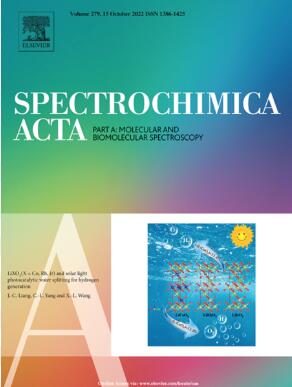Methyl-free meso-thiazole-substituted red-shifted BODIPY-based molecular rotor for fluorescence imaging viscosity in mitochondria
IF 4.3
2区 化学
Q1 SPECTROSCOPY
Spectrochimica Acta Part A: Molecular and Biomolecular Spectroscopy
Pub Date : 2025-06-30
DOI:10.1016/j.saa.2025.126626
引用次数: 0
Abstract
Molecular fluorescent rotors based on boron dipyrromethenes (BODIPYs) were intensively explored for monitoring the environmental viscosity variations, due to its critical functions in many associated diseases. Although various strategies have been used, red-shifted BODIPY-based fluorescent rotors with large Stokes shifts through one-step reaction remain a challenging topic due to the tedious synthetic procedures. In this manuscript, for the first time, through one-step reaction, 1,7-dimethyl-free meso-thiazole/benzothiazole BODIPYs were used to construct red-shifted fluorescent rotors with large Stokes shifts, which could be used for monitoring cellular viscosity changes with mitochondrial localization. This strategy-designed 1,7-dimethyl-free meso-thiazole/benzothiazole BODIPYs could be prepared through one-step reaction, giving emissions over 600 nm and large Stokes shifts of about 70 nm. Both meso-thiazole probe 3 and meso-benzothiazole probe 5 could sense the viscosity changes through fluorescence turn-on effects with low detection limits, depending on efficiently restricting the rotation of the meso-thiazole in viscous systems. Cellular experiments further validated that probe 3 showed nearly no cytotoxicity towards HeLa cell and relatively good mitochondria-targeting ability over lysosomes, which was further employed to detect intracellular viscosity variations induced by lipopolysaccharide (LPS) and monensin. Therefore, red-shifted 1,7-dimethyl-free meso-thiazole BODPY-based fluorescent probe through one-step reaction could serve as sensitive molecular rotors for visualizing viscosity variations in mitochondria of HeLa cells.

无甲基间噻唑取代红移bodipy分子转子用于线粒体荧光成像粘度
基于二吡咯甲基硼(BODIPYs)的分子荧光转子由于其在许多相关疾病中的关键功能而被广泛用于监测环境粘度变化。虽然已经使用了各种策略,但由于合成过程繁琐,通过一步反应获得具有大斯托克斯位移的红移bodipy荧光转子仍然是一个具有挑战性的话题。本文首次通过一步反应,利用无1,7-二甲基的中噻唑/苯并噻唑BODIPYs构建具有大Stokes位移的红移荧光转子,用于监测线粒体定位时细胞粘度的变化。该策略设计的不含1,7-二甲基的中噻唑/苯并噻唑BODIPYs可以通过一步反应制备,其发射光谱超过600 nm, Stokes位移约为70 nm。介噻唑探针3和介苯并噻唑探针5均能通过荧光开启效应感知黏性变化,检测限低,主要依赖于有效限制介噻唑在黏性体系中的旋转。细胞实验进一步验证了探针3对HeLa细胞几乎没有细胞毒性,并且对溶酶体具有较好的线粒体靶向能力,进一步将其用于检测脂多糖(LPS)和莫能菌素诱导的细胞内粘度变化。因此,通过一步反应,基于红移1,7-二甲基无中噻唑体的荧光探针可以作为观察HeLa细胞线粒体粘度变化的敏感分子转子。
本文章由计算机程序翻译,如有差异,请以英文原文为准。
求助全文
约1分钟内获得全文
求助全文
来源期刊
CiteScore
8.40
自引率
11.40%
发文量
1364
审稿时长
40 days
期刊介绍:
Spectrochimica Acta, Part A: Molecular and Biomolecular Spectroscopy (SAA) is an interdisciplinary journal which spans from basic to applied aspects of optical spectroscopy in chemistry, medicine, biology, and materials science.
The journal publishes original scientific papers that feature high-quality spectroscopic data and analysis. From the broad range of optical spectroscopies, the emphasis is on electronic, vibrational or rotational spectra of molecules, rather than on spectroscopy based on magnetic moments.
Criteria for publication in SAA are novelty, uniqueness, and outstanding quality. Routine applications of spectroscopic techniques and computational methods are not appropriate.
Topics of particular interest of Spectrochimica Acta Part A include, but are not limited to:
Spectroscopy and dynamics of bioanalytical, biomedical, environmental, and atmospheric sciences,
Novel experimental techniques or instrumentation for molecular spectroscopy,
Novel theoretical and computational methods,
Novel applications in photochemistry and photobiology,
Novel interpretational approaches as well as advances in data analysis based on electronic or vibrational spectroscopy.

 求助内容:
求助内容: 应助结果提醒方式:
应助结果提醒方式:


